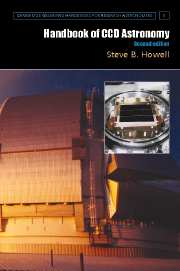Book contents
- Frontmatter
- Contents
- Preface to the first edition
- Preface to the second edition
- 1 Introduction
- 2 CCD manufacturing and operation
- 3 Characterization of charge-coupled devices
- 4 CCD imaging
- 5 Photometry and astrometry
- 6 Spectroscopy with CCDs
- 7 CCDs used in space and at short wavelengths
- Appendices
- References
- Index
5 - Photometry and astrometry
Published online by Cambridge University Press: 05 June 2012
- Frontmatter
- Contents
- Preface to the first edition
- Preface to the second edition
- 1 Introduction
- 2 CCD manufacturing and operation
- 3 Characterization of charge-coupled devices
- 4 CCD imaging
- 5 Photometry and astrometry
- 6 Spectroscopy with CCDs
- 7 CCDs used in space and at short wavelengths
- Appendices
- References
- Index
Summary
One of the basic astronomical pursuits throughout history has been to determine the amount and temporal nature of the flux emitted by an object as a function of wavelength. This process, termed photometry, forms one of the fundamental branches of astronomy. Photometry is important for all types of objects from planets to stars to galaxies, each with their own intricacies, procedures, and problems. At times, we may be interested in only a single measurement of the flux of some object, while at other times we could want to obtain temporal measurements on time scales from seconds or less to years or longer. Some photometric output products, such as differential photometry, require fewer additional steps, whereas to obtain the absolute flux for an object, additional CCD frames of photometric standards are needed. These standard star frames are used to correct for the Earth's atmosphere, color terms, and other possible sources of extinction that may be peculiar to a given observing site or a certain time of year (Pecker, 1970).
We start this chapter with a brief discussion of the basic methods of performing photometry when using digital data from 2-D arrays. It will be assumed here that the CCD images being operated on have already been reduced and calibrated as described in detail in the previous chapter. We will see that photometric measurements require that we accomplish only a few steps to provide output flux values. Additional steps are then required to produce light curves or absolute fluxes.
- Type
- Chapter
- Information
- Handbook of CCD Astronomy , pp. 102 - 134Publisher: Cambridge University PressPrint publication year: 2006
- 2
- Cited by

